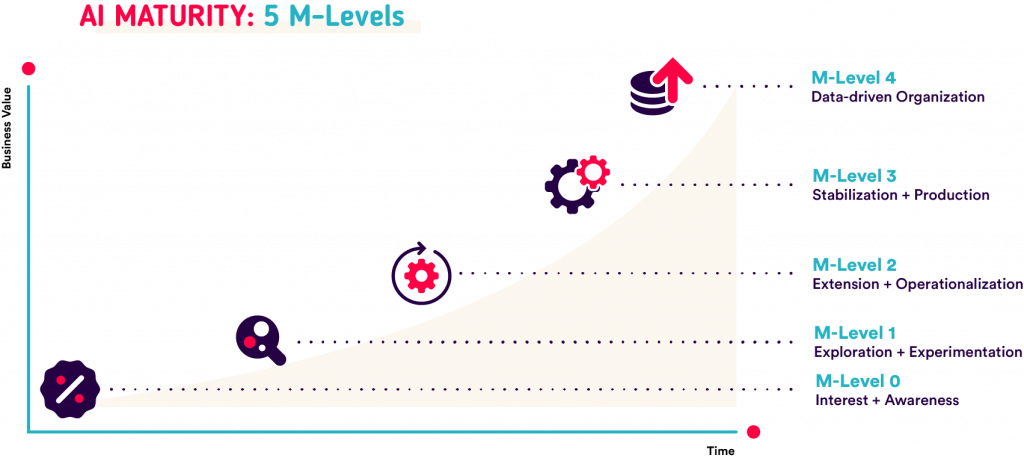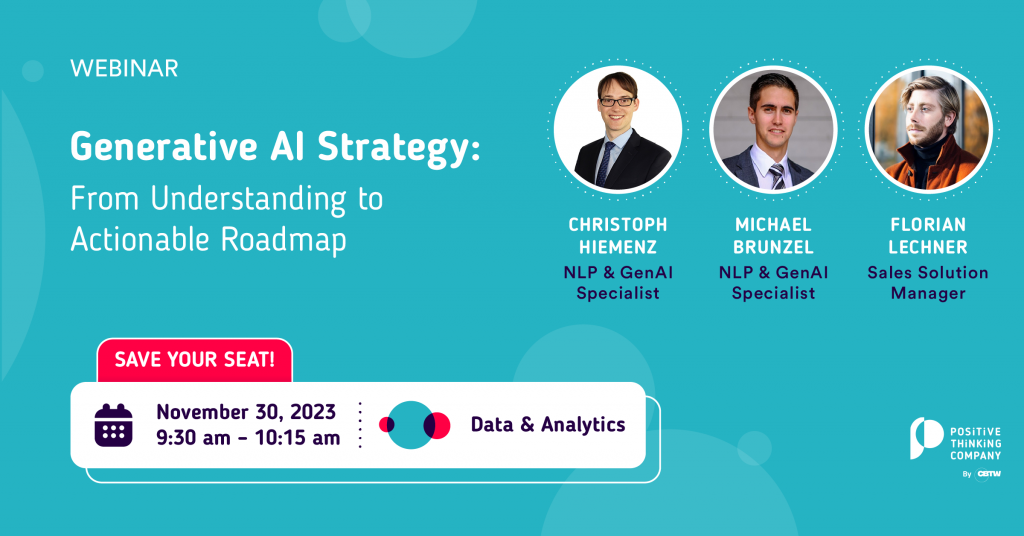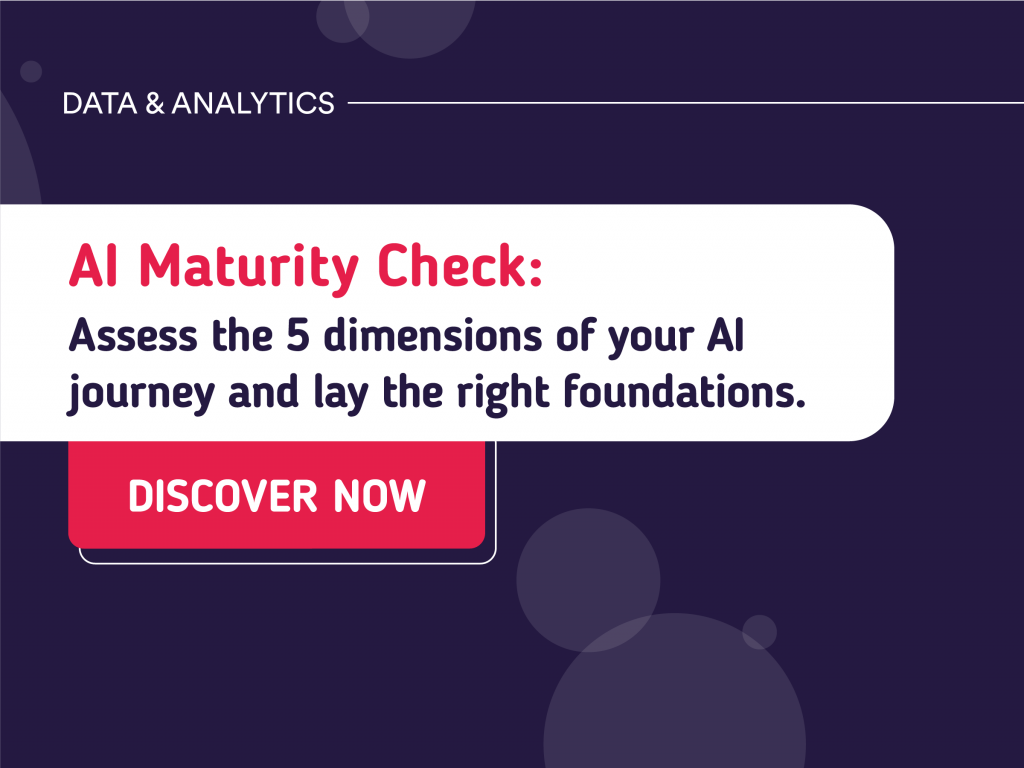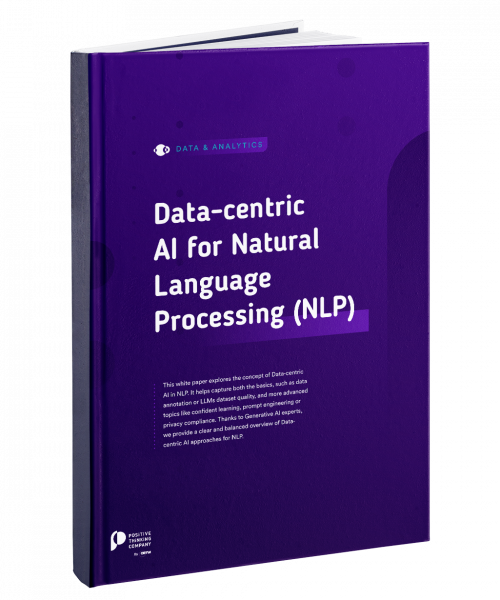That the use of AI can be profitable is a fact that is widely known already. Almost every organization is aware of AI and every large enterprise has successfully implemented AI use cases. We all agree that it can add value, but in most cases the big mission “introducing AI” starts with no clear strategy. In fact, it usually starts by experiments together with young data scientists.
This approach can be good to get started and to understand the potential, but it bares the risk that the great introduction of AI fails – latest, when it comes to extension & operationalization of AI. And here is why: in order to be successful, business value needs to be at the center of discussions. At the same time, it is not easy to connect AI with business value right away. Only a strategic approach which combines innovative AI and business goals can do the job.
We Assess AI in Five Maturity Levels
Based on our experience over the years, we defined a very pragmatic framework around the maturity in the use of AI.

It all starts in the first phase with interest and awareness for AI. The second phase is characterized by explorations and experimentation. During this phase, several PoCs (proof of concepts) are carried out. During the first two phases no positive returns are to be expected.
After first success stories proving the general feasibility, organizations start to extend and operationalize AI. During this phase, MVPs (Minimal Viable Products) replace PoCs and MLOps enters the scene and determines the next phase which is about stabilization and production. When all these phases have been successfully completed, it is time to expand the usage of AI and this is where all business users come into play. The duo “data” and “AI” can only be a winning team if we push the use of AI beyond the boundaries of data + AI teams and include all business users.
Data literacy and self-service analytics up to self-service AI are the most important keywords in order to achieve the last level in being a data-driven company. Depending on the AI maturity level, the return on investment in AI increases. But especially during the first two phases, an actionable strategy is often neglected and most often after ongoing activities for several months up to years the organizations are faced with the challenge of operationalizing AI. For that, all business units and IT need to be aligned organizationally, technically and procedurally – and this alignment is much more difficult to perform when there was no AI strategy in place before. So let’s have a look at the most common challenges when implementing AI.
Most Common Challenges When Implementing AI
One of the biggest challenges when implementing or extending the use of AI is the formulation of clear goals and actions. Implementing AI just for AI’s sake is not a sufficient definition of goals. Neither the implementation because “everybody is using it”. In many cases, we observe a gap between the visions of the C-levels and the respective tasks that need to be performed to achieve this vision in the corresponding teams. This gap usually occurs when there is no further definition of what is specifically to be achieved with the help of AI, meaning clear use cases. Consequently, the respective steps and actions to be taken are difficult to derive. And as a further consequence, the organization tends to get stuck in PoCs or are getting lost in detail on infrastructure or algorithms. This again leads to inefficiency and further loss of focus.
A different field of challenges is closely related to this. AI is an absolute hype and fear topic and these expectations need to be managed properly. If people never worked with AI, it is actually hard to have a proper level of expectations. Either people are expecting too much, or people are not expecting enough or are even afraid of AI. Next to managing expectations, proper change management is required. People need to be part of the journey and need to understand the purpose of changes. And these missions of proper change and expectation management can both not be successful if the introduction of AI seems to be haphazard and inefficient.
For more mature organizations – where it is about extension and operationalization of AI – these challenges stay, and further challenges emerge. Especially the processes and infrastructure around AI products require a clear roadmap for all stakeholders. At the latest for operations, business and IT needs to be aligned. And in most cases not only one business department, but all who are involved as a central operation of AI products is the most frequent scenario today. If that is not managed well, there is a significant risk that chaos will take over.
The fact that AI solutions require interdisciplinarity and are complex make it quickly difficult to achieve an actionable AI strategy. At the same time, next to a long-term strategy including planning and roadmapping, we need agile and iterative development. But only focusing on short term agility may lead to moving in the wrong direction for too long – frustration and disappointment will follow. So, in order to avoid all these challenges, an actionable and proper AI strategy for every maturity level is required.

AI Strategy as the Solution to Address these Challenges
After discussing all the challenges that are lurking around when implementing and enhancing the use of AI, the good news is that there is a solution: a proper and actionable AI strategy.
This strategy has to be developed for each AI maturity level and it is never too late to start leveraging it. The sooner the better, of course. For each maturity level, the focus of the strategy changes and it is important to have in mind the future scalability when starting.
The very first thing to do is to get all stakeholders around the table. The stakeholders must include representatives from C-level, the business units and from IT as the implementation and extension of AI requires interdisciplinary teams and stakeholders. The goal of such an AI strategy is to get a clear vision and finding a focus. We recommend a business case driven approach and assessing the expected business value of each use case in the very beginning. This approach ensures that organizations effectively combine AI and business value by design. When we know which cases we want to implement or operationalize, we can derive the corresponding requirements on what we need in order to achieve this vision. This comprises all requirements for architecture, data, team size, roles and processes.
This vision and clear planning for achievement of it forms the so-called Analytical Roadmap. As soon as the Analytical Roadmap is developed, the whole mission of introducing or extending the use of AI has a clear focus. The roadmap and focus allow for transparency and make it easier to get everybody on bord (keyword: Change Management!). At the same time this approach reduces the risk of getting lost in agile experiments in interdisciplinary fields as clear roadmapping and classy planning allow for tight project controlling. This combination of a clear and transparent framework through the roadmap and at the same time freedom for experimental procedures forms the perfect basis for successful use of AI.
No matter on which maturity level an organization is, in order to address AI challenges, an actionable AI strategy is key for success.











